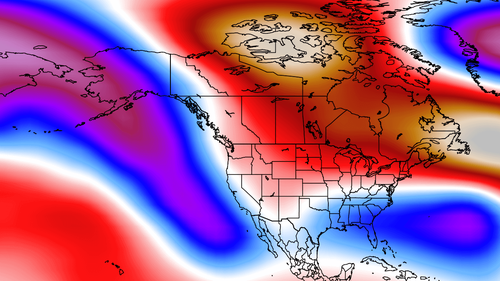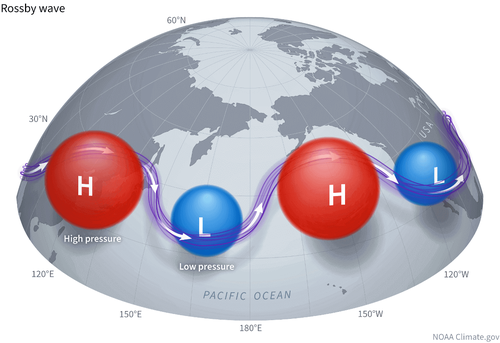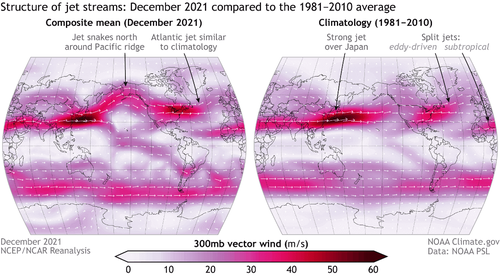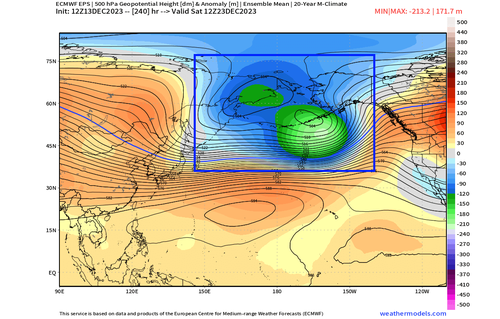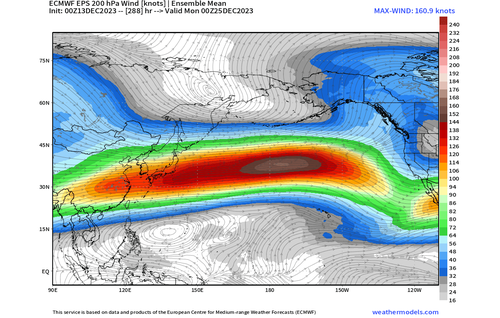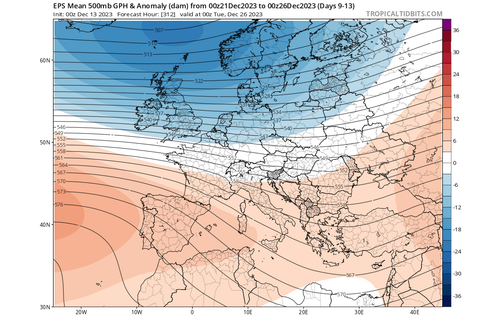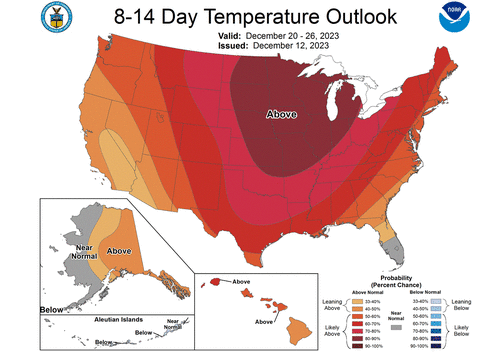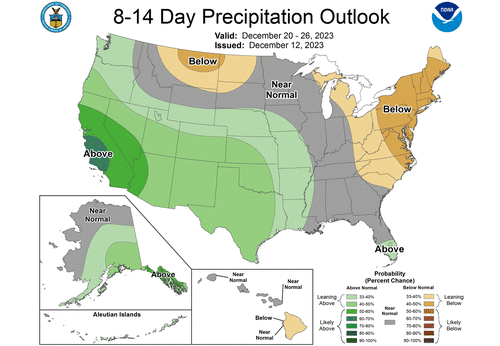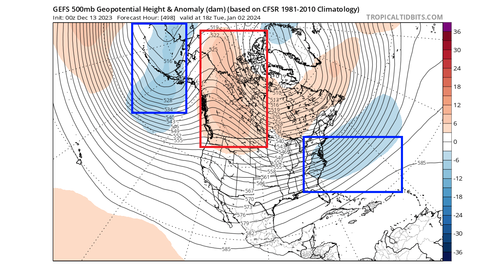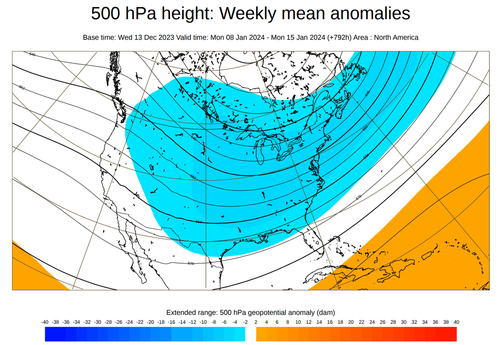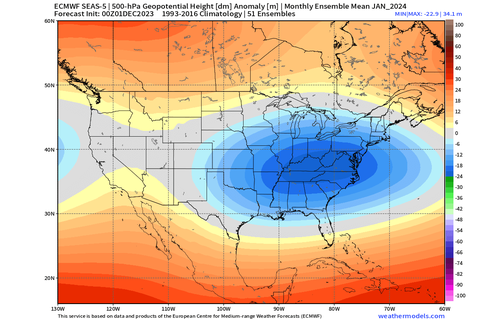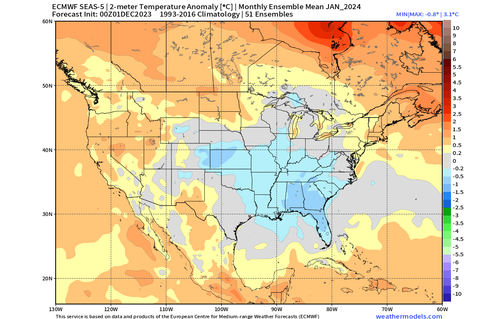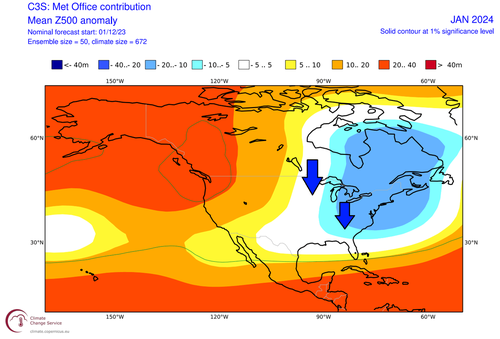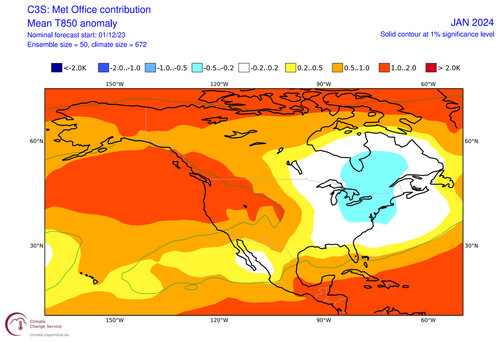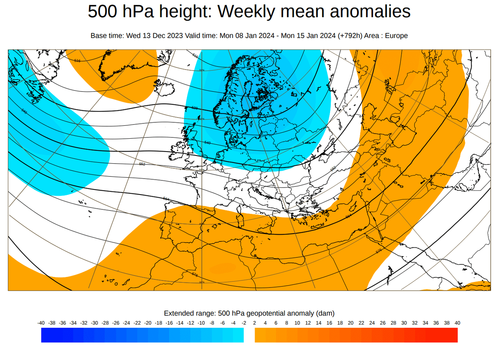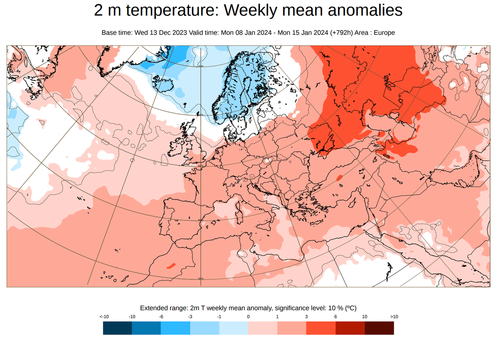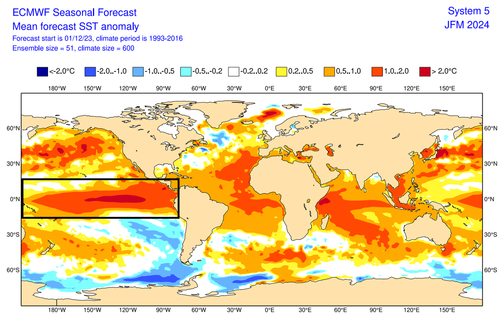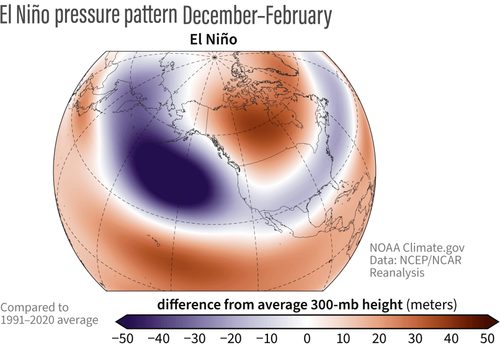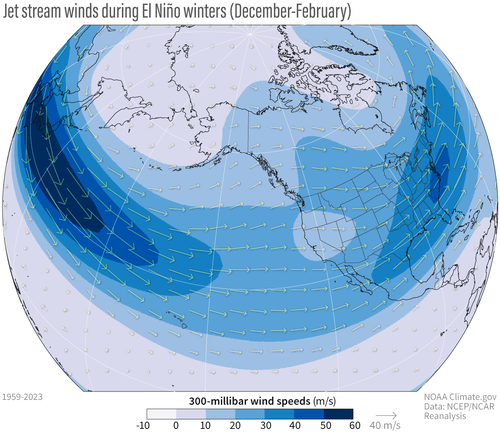The weather condition blog site Extreme Weather Condition Europe offers a thorough analysis of ” cold abnormalities throughout much of the main, southern, and eastern United States” after the start of the brand-new year.
This news must delight our United States readers given that a lot of them have actually been experiencing higher-than-average temperature levels due to El Niño.
The impact of the El Nino continues to grow, assisting to develop a strong Jet Stream pattern over the Pacific Ocean, bringing heat into The United States and Canada. However a pattern modification is still on course for January. https://t.co/iD0a8DTm2e
— severe-weather. EU (@severeweatherEU) December 14, 2023
* * *
Winter season 2023/2024 has actually started in a really vibrant method. Presently, we have a strong train of pressure waves throughout the Pacific and into The United States And Canada. That will develop into a strong low-pressure system, driving an effective jet stream and warmer air over the United States, simply to be changed in early 2024 by a huge winter pattern modification.
A low-pressure location is anticipated to establish over the North Pacific in the next couple of days and will produce a strong jet stream pattern that will press the moderate ocean air into The United States and Canada. However it is not anticipated to last long, as appropriate winter season is presently arranged to show up in January.
We will initially take a look at the most recent weather condition patterns and the uncommon jet stream advancement projection. You will likewise see how Winter season is anticipated to show up in January, and we will likewise take a look at what is driving the environment from one extreme to the other.
WAVES IN THE ENVIRONMENT
The existing weather condition pattern throughout the North Pacific and The United States And Canada is really vibrant. In the image listed below, you can see the most recent pressure abnormalities in a wave-like pattern. Such pressure waves are an effort of the environment to cancel the temperature level distinction in between the cold poles and the warm tropics.
These sets of pressure systems are likewise called Rossby Waves You can see an example of Rossby waves in the image listed below by NOAA. As you can see, the existing pattern above is rather a book example of a Rossby wave train from the Pacific into The United States And Canada.
The violet line linking these pressure systems is the jet stream. It drives and engages with the pressure systems, therefore assisting to straight affect our day-to-day weather condition. That is why any modifications in the jet stream are really essential to keep an eye on.
The term jet stream lags severe occasions, from cold spells and flooding to heatwaves and dry spells. It is a quickly, narrow current of air streaming from west to east that surrounds the world. In the image listed below, you can see an example of the worldwide jet stream in a NOAA analysis.
This all comes together if we take a look at the most recent temperature level abnormalities throughout the Pacific and The United States And Canada. Similar to with pressure abnormalities, you can see the temperature level waves of warm and cold zones. As a warm abnormality exists over the northern United States and Canada, a colder-than-normal abnormality is over the northeastern United States.
These temperature level patterns straight represent the high and low-pressure systems and the jet stream that links them. The greatest cold is typically discovered when the jet stream is wavy, and these pressure waves are strong, and the low-pressure location of the wave is straight over the United States.
However there is a reason that we are taking a look at the existing pattern and finding out about pressure waves and the jet stream.
In the coming days, the vibrant waves in the North Pacific will be changed by a big and strong low-pressure location, producing a more direct jet stream and having a strong weather condition effect over the United States and Canada.
AS THE PRESSURE DROPS
Throughout winter season, the pressure systems tend to be more powerful, particularly lows. As there is a great deal of energy included, the weather condition systems are continuously in movement and communicating with each other. This can bring along pattern modifications on a bigger scale, one like we will see unfold in the 2nd half of December.
The graphics listed below reveal the ensemble projection from the ECMWF information, honestly offered by the Copernicus information center. Images are supplied by weathermodels.com, utilizing an industrial license.
Looking 10 days ahead, you can see in the projection listed below that a broad low-pressure location is anticipated to establish over the Aleutians. This will change the typical train of much shorter pressure waves and produce a more direct pattern.
This longer wave pattern can be seen in the projection listed below for the vacations. You can see a broad low-pressure location over the ocean and a big high-pressure location over The United States and Canada. This is the exact same Rossby wave pattern as you saw in the start, however in a longer type.
What this does is 2 things. Initially, it produces a strong pressure distinction. And strong pressure distinction suggests strong winds. This brings strong westerly and southwesterly low-level winds into the western United States and western Canada and, with it, milder ocean air.
2nd, it produces a really strong jet stream in the upper levels. You can see it in the graphic listed below, revealing the wind speed at the 200mb level (12km/7.4 miles). This assists to bring much warmer air mass into the United States, in addition to wetness.
To put that into viewpoint, you can see the temperature level abnormalities on the 10-day projection listed below. The warmer ocean air will develop a really strong temperature level anomaly over much of The United States and Canada. This likewise suggests that the holiday is going to be warmer than regular throughout much of the United States.
WEATHER CONDITION FROM THE WEST
As stated, the strong westerly circulation brings warmer abnormalities over the North American continent. Looking better at the United States, you can see the temperature level anomaly in the lower levels. Basically the whole nation will be under warmer-than-normal temperature levels over the vacations.
Looking particularly at surface area temperature levels, you can see the day-to-day temperature levels not dropping to freezing levels. The exception is the far northern United States and greater elevations over the Rockies. Naturally, Canada is still anticipated to have below-freezing temperature levels, regardless of the strong warm abnormalities, due to its northern place.
A comparable pattern is likewise seen over Europe, where a low-pressure system over the northern areas drives a milder westerly circulation from the Atlantic as it spins counter-clockwise.
The temperature level anomaly anticipated over Europe is not as highly warmer as over the United States and Canada, however you can see that it does avoid any significant cold air break outs or lasting northern circulations into the mainland.
The NOAA 8-14 day temperature level outlook summarize this projection duration for the United States. Warmer than regular weather condition is forecasted over much of the nation, leading into the last week of December.
A strong jet stream likewise brings a great deal of wetness from the ocean into the United States. In the NOAA rainfall projection listed below for the exact same duration, you can see much above-normal rainfall over the western and southern parts of the United States.
However if you like winter season and snow, and these images make you feel unfortunate, do not stress. There is more winter season still to come, both on the calendar and, as you will see, likewise in the environment.
WINTER SEASON MODIFICATION IN JANUARY
Taking a look at the ensemble projection, we can see modifications in the weather condition patterns beginning around the brand-new year In the image listed below, you can see the North Pacific low-pressure location bring up to the north, permitting the high-pressure location over Canada to withdraw to the west and north.
That makes it possible for the low-pressure location to take control of the main and eastern United States, like an undercut listed below the high-pressure location. It is still simply waves of pressure abnormalities, like we revealed you in the start, communicating with each other.
The significant modifications are then shown for the 2nd week of January, as seen in the image listed below. This pressure pattern from the extended ECMWF projection brings along entirely various day-to-day weather condition. You can see a broad low-pressure location covering much of the United States.
The temperature level projection listed below, for the exact same duration, reveals broad cold abnormalities throughout much of the main, southern, and eastern United States This shows the westerly circulation is being changed by a cooler northern circulation. Compared to what we will see in the next 2 weeks, such pattern modification would be really welcome in early 2024 if you want cooler weather condition and some snowfall.
Taking A Look At the GEFS design for the exact same duration, it reveals the precise very same temperature level pattern. It is possibly a bit previously with the cooler air than the ECMWF, however at this prolonged variety, the bottom line is that both (various) designs settle on the exact same result, which is an unusual sight.
A comparable contract of various designs is likewise seen in the monthly/seasonal projection, which is an even larger task.
JANUARY MONTHLY PROJECTION
These pressure modifications were currently shown in the month-to-month January pressure projection recently. Listed below, you can see a broad low-pressure system throughout the eastern and main United States. This remains in coupling with a high-pressure zone over southern Canada and a ridge over the western United States.
In the January temperature level projection, you can see the cold air abnormality over the main Plains, upper Midwest, and much of the eastern United States. Southern Canada and the western United States are warmer than regular due to the high-pressure impact.
Another design that concurs with this service is the UKMO. Below is its pressure anomaly anticipated for January over The United States And Canada. It likewise reveals a more comprehensive low-pressure location over the eastern United States and Canada, allowing a more northern air flow.
This is shown in the lower environment temperature level anomaly anticipated for January, which reveals the primary colder-than-normal location over the eastern United States and southeastern Canada. Similar to in the ECMWF, the warmer abnormalities stay over the west, under the high-pressure ridge location.
These projections are a regular monthly average, so unlike the weekly projection above, they can disappoint as lots of extremes. However to see such a pattern modification on a regular monthly average is a great indication for the weather condition patterns to really turn in early 2024.
A modification is likewise seen for Europe as we get in January. The weekly pressure abnormality projection reveals a low-pressure location dropping into the main parts. This would a minimum of briefly damage the westerly circulation and increase the snowfall capacity over the main and northern parts.
Taking a look at the temperature level projection, that cold abnormality is no place to be discovered other than for the far northern parts. This is intriguing and is not actually constant with what the pressure pattern recommends.
We do need to include that projections for Europe do tend to have some abnormalities in the prolonged variety, as the motorists behind the weather condition patterns tend to have a less direct effect than over The United States and Canada.
However who are these “motorists,” and why do we even have such big swings from red-hot projection maps to unexpected modifications into cooler patterns?
The response is not so basic, as we have ocean abnormalities, the Polar Vortex, MJO, and so on. However there is one significant element this winter season that has an essential impact on the jet stream and, therefore, on the day-to-day weather condition over the United States and Canada.
As you have actually most likely heard previously, that is the strong El Niño occasion in the Pacific Ocean. We will take a look at El Niño in this post, as it is straight associated to the upcoming jet stream advancement.
EL NINO WEATHER CONDITION GAMES
El Niño Southern Oscillation (or ENSO) is an area of the equatorial Pacific Ocean that occasionally alters in between warm and cold stages. Generally, there is a modification around every 1-3 years from one stage to another.
We are presently in a warm stage called El Niño, which is anticipated to last into Spring 2024.
Below is likewise an ocean surface area anomaly anticipated for the January-March duration. You can see the El Niño anomaly marked in the tropical Pacific. The projection reveals a basin-wide occasion of a strong magnitude.
This advancement is very important since modifications in ocean temperature levels likewise bring along modifications in pressure and rainfall patterns in the tropics. And through those modifications, the effect of the El Niño occasion is dispersed into the worldwide flow.
Listed below, you can see the typical El Niño winter season pressure abnormalities. Notification the strong low-pressure abnormality in the North Pacific, precisely like we have actually seen in the projection for the rest of December. Likewise, you can see the high-pressure location over Canada and the northern United States
This reveals with self-confidence that the upcoming warm pattern is to be anticipated in El Niño winter seasons. That is likewise obvious when you see the image listed below, which reveals the normal jet stream pattern in such winter seasons. You can see an enhanced subtropical jet stream. This is the exact same pattern that will affect the weather condition over The United States and Canada in the next 2 weeks.
We can see all this information integrated in the next NOAA image listed below, suggesting the typical weather condition throughout the El Niño winter.
You can see the strong and consistent low-pressure location in the North Pacific. That presses the polar jet stream even more north, bringing warmer-than-normal temperature levels to the northern United States and western Canada.
The southerly Pacific jet stream is extended and magnified throughout an, bringing low pressure and storms with great deals of rainfall and cooler weather condition to the southern and southeastern United States.
This is a little various than what we will see in the next weeks, however notification that the image above is a seasonal average. It reveals information from 3 months or more.
If you think about the modification to a cooler weather condition pattern in January, the total long-lasting average may wind up looking really near the normal El Niño winter season.
Below is the temperature level analysis by NOAA, which reveals the variety of previous El Niño occasions that were regularly warmer or cooler. It exposes that throughout these occasions, the winter seasons are regularly cooler than typical throughout the southern half of the United States and up into the northeast.
This reveals the 3-month average, which suggests that there is a total propensity to have durations of cooler weather condition throughout the eastern and northeastern United States. And likewise cooler than regular conditions over the southern states.
So, as December ends much warmer than regular, it is quite most likely for January and February to repair the seasonal average back to regular with some cold.
You can discover more about the anticipated winter season weather condition and pressure modifications for January and February 2024 in our most current seasonal outlook post:
Authored by Andrej Flis of Extreme Weather Condition Europe by means of Zerohedge.com
.
